|
The image below
is a higher-resolution version of the Lae takeoff photo featured in
The Lost Antenna.
This photograph has not been sharpened, altered or enhanced in any way.
It clearly shows that, although the loop, dorsal mast, pitot tube, and
possibly the center ventral mast are present, the aft ventral mast appears
to be missing.
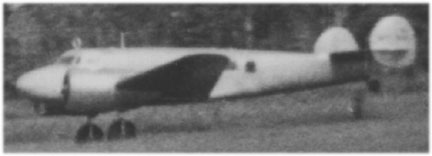
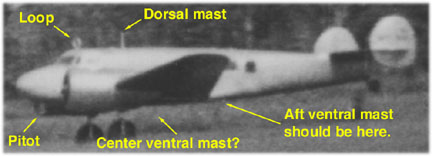
It
could be argued, however, that our inability to see the mast does not
prove that it wasn’t there. (You can not prove a negative hypothesis.)
However, it now appears that there is positive evidence of the suspected
takeoff accident that deprived the aircraft of its belly wire antenna.
TIGHAR
has advanced the hypothesis that between the time the aircraft taxiied
out for takeoff and the time it made its actual takeoff run, the aft central
mast suffered a ground strike which broke it loose from the fuselage and
left it dragging on the ground by the wire still attached to the center
mast and the starboard side pitot tube.
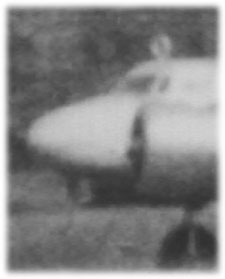 The
most likely time for the suspected ground strike may have been while the
tail of the overloaded aircraft was being swung around at the far end
of the runway to position the airplane for takeoff. The mast was not stressed
for side loads. An abrupt puff of dust visible in the takeoff
film may be the broken mast, dragged by the antenna wire, snagging
on the ground and tearing the wire loose. Such an event would put a tremendous
strain on the wire’s anchor point – the starboard pitot – and might
logically deform that structure rearward. The takeoff photo shows quite
clearly that the Earhart Electra has suffered exactly this kind of damage. The
most likely time for the suspected ground strike may have been while the
tail of the overloaded aircraft was being swung around at the far end
of the runway to position the airplane for takeoff. The mast was not stressed
for side loads. An abrupt puff of dust visible in the takeoff
film may be the broken mast, dragged by the antenna wire, snagging
on the ground and tearing the wire loose. Such an event would put a tremendous
strain on the wire’s anchor point – the starboard pitot – and might
logically deform that structure rearward. The takeoff photo shows quite
clearly that the Earhart Electra has suffered exactly this kind of damage.
The
“pitot” (pronounced PEE-toh) tubes are the “L” shaped
devices protruding from the “chin” of the aircraft. All aircraft
have them. They are part of the system that determines how fast the aircraft
is moving through the air. The pressure exerted by “ram” air
entering through the open end of the forward-pointing tube is compared
with “static” air collected at a “dead” spot somewhere
on the fuselage, and the difference is displayed to the pilot via the
airspeed indicator in the cockpit. Earhart’s Electra had two
pitot tubes because she had two airspeed indicators, one on the pilot’s
side of the cockpit and a backup on the copilot’s side. The pitot tube
on the copilot’s side also doubled as a forward anchor point for the belly
wire antenna. It is, of course, essential for the proper functioning of
the pitot that the ram air tube be aligned with the aircraft’s
longitudinal axis, as illustrated in this photo taken of NR16020 taken
immediately prior to its departure on the second World Flight attempt.
If you look closely you can even see the antenna wire attached to the
back of the starboard pitot a few inches above the ram air tube.
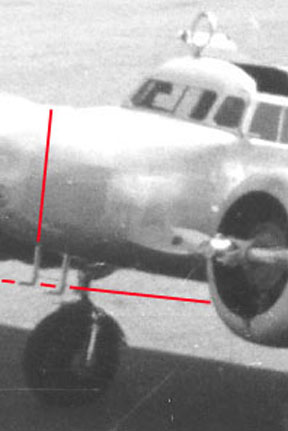 The
light seems to be catching only one of the two pitots in the Lae takeoff
photo, but drawing the same lines as in the photo above leaves no doubt
that the pitot tube that is visible has been significantly deformed downward
and backward. The
light seems to be catching only one of the two pitots in the Lae takeoff
photo, but drawing the same lines as in the photo above leaves no doubt
that the pitot tube that is visible has been significantly deformed downward
and backward.
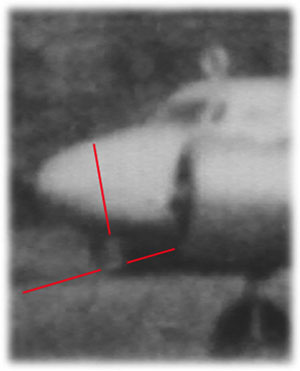
It
is inconceivable that the aircraft would have left the hangar with such
an obvious defect. However, it is also clear that by the time the aircraft
was photographed during its takeoff run, one of the pitot tubes had suffered
serious damage. The port side pitot was not attached to any external structure
and it’s hard to imagine how it could have sustained such damage short
of the aircraft colliding nose-first into something. The conclusion, therefore,
seems inescapable that the pitot tube visible in the photo is the staboard
side unit and that the deformation that is apparent was caused by the
events suggested by the absence of the aft mast and the evidence of impact
(puff) seen during the takeoff run.
|



 The
most likely time for the suspected ground strike may have been while the
tail of the overloaded aircraft was being swung around at the far end
of the runway to position the airplane for takeoff. The mast was not stressed
for side loads. An abrupt puff of dust visible in the
The
most likely time for the suspected ground strike may have been while the
tail of the overloaded aircraft was being swung around at the far end
of the runway to position the airplane for takeoff. The mast was not stressed
for side loads. An abrupt puff of dust visible in the  The
light seems to be catching only one of the two pitots in the Lae takeoff
photo, but drawing the same lines as in the photo above leaves no doubt
that the pitot tube that is visible has been significantly deformed downward
and backward.
The
light seems to be catching only one of the two pitots in the Lae takeoff
photo, but drawing the same lines as in the photo above leaves no doubt
that the pitot tube that is visible has been significantly deformed downward
and backward.
